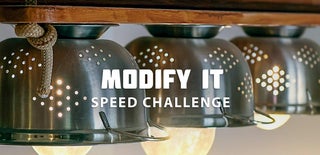Introduction: Mini Drone to Mini Electrical Generator
I've had a mini drone for a couple of years and while it's been fun to fly, of late the battery isn't lasting very long so I thought I would see if it could be converted into a mini generator.
Supplies
Mini drone
4 empty beer cans
Red LED
Hook up wire
Aluminium tube
Tools:
Soldiering iron
Wire cutters
Hot glue gun
Multimeter
Knife
Scissors
Tin snips
4 empty beer cans
Red LED
Hook up wire
Aluminium tube
Tools:
Soldiering iron
Wire cutters
Hot glue gun
Multimeter
Knife
Scissors
Tin snips
Step 1: Disassemble Drone
The drone was disassembled by removing the blades, taking the cover off and then removing the small motors.
Step 2: Trail Run
I tested to see if the motors could make electricity by connecting one to a multimeter and blowing on its blades. I understand not all drone motors can be used as generators. The motor generated power. I then connected the 4 motors in series and connected a red LED. When I attached it to my bike and went for a ride I noticed the blades would only turn at a fast pace and the LED did not light up.
When I had the opportunity I tried it out while traveling in a car and hanging it out a window. Once the car got above 40 KPH the red LED lite up. This is too fast a speed for me to cycle at. This instructable shows how you can make the blades turn at a slower speed by using some beer cans.
When I had the opportunity I tried it out while traveling in a car and hanging it out a window. Once the car got above 40 KPH the red LED lite up. This is too fast a speed for me to cycle at. This instructable shows how you can make the blades turn at a slower speed by using some beer cans.
Step 3: Disassemble Some More
As I would be using some turbines made from the base of beer cans I realized they would not fit in the existing housing as their diameter was too wide.
The motors were removed and the existing housing cut in quarters with a hacksaw blade. At this stage I wondered if they could be reassembled again...
The motors were removed and the existing housing cut in quarters with a hacksaw blade. At this stage I wondered if they could be reassembled again...
Step 4: Make 4 Turbine Blades (1)
Turbine blades can be made from the base of beer cans.
- Cut the base off with a knife and scissors.
- Trim around the bottom disk to make a circle.
- Punch a hole in the center with a nail.
- Cut the base off with a knife and scissors.
- Trim around the bottom disk to make a circle.
- Punch a hole in the center with a nail.
Step 5: Make Turbine Blades (2)
The fins of the turbines are then cut using tin snips. Form the fins so when air passes through they will rotate.
I wanted 2 to rotate left and the other 2 to rotate right and so shaped the fins to achieve this.
I wanted 2 to rotate left and the other 2 to rotate right and so shaped the fins to achieve this.
Step 6: Fix Generator Housings
The housing, which had previously been cut into quarters, was fixed to an aluminum tube. This was achieved with some drilling and use of the hot glue gun.
Step 7: Check Generators Polarity
Electrical wire was soldiered to the generators so their polarity could be checked using a multimeter and turning the generators by hand. The negative wire was coloured black with a marker.
Step 8: Glue on Turbine Blades
The beer can turbines were attached to the existing blades using the hot glue gun.
I wanted them to turn towards the centre and this was checked.
I wanted them to turn towards the centre and this was checked.
Step 9: Wire in Series
When the generators had previously been checked using the multimeter and blowing on the blades it was found about 30 Milliamps were produced from each one but only about 0.3 volts. In order to light the LED they would need to be connected in series.
This was done by connecting 2 together and checking the voltage had increased using the multimeter, adding the next generator and checking again. This was easier than trying to work out the theory as a couple of them wouldn't be turning in the same rotation.
This was done by connecting 2 together and checking the voltage had increased using the multimeter, adding the next generator and checking again. This was easier than trying to work out the theory as a couple of them wouldn't be turning in the same rotation.
Step 10: Generating Power
The tube with the 4 mini generators was then attached to the handlebars of my bike and taken for a ride. They rotated at a lower speed than before but the LED still didn't light up. I hope it will when going down a steep hill at speed.
Step 11: Adding a Voltage Booster
Update: In order to get the LED to light up at riding speed, I learnt about 'voltage boosters'. I installed one. Then fixed a Headtouch with one.
I also changed the LED to one which lite at 1.8 volts. In order to test this with a 9 volt battery, I came up with a Variable Resistor.
Step 12: Final Testing
The mini generator was then tested again at my downhill test track and Success! - the red light came on with brisk cycling.

Participated in the
Modify It Speed Challenge











